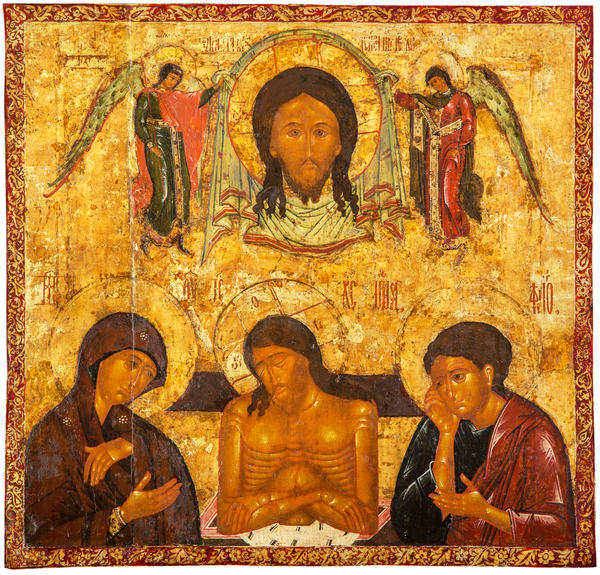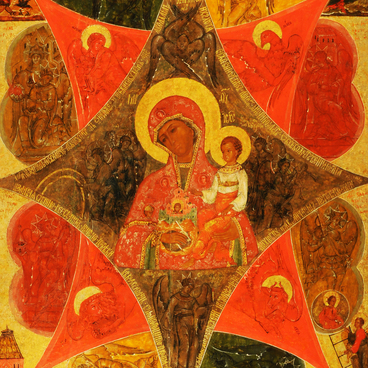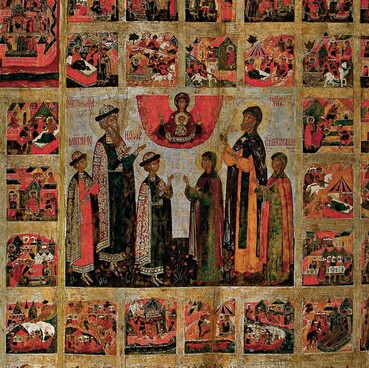The icon with the Vernicle Image of the Saviour was created by an unknown icon-painter in the early third part of the 17th century. Initially the icon was kept in the wooden church of the Vernicle Image of the Saviour in Murom. Later it was moved to the Nikolo-Mozhaisk (Kazan) church. According to a church legende, this image was created with the funds of Tsar Mikhail Romanov.
The icon’s composition is a scene of lamentation over Jesus Christ after his death. A counterpart of this iconography in Western art is the sculpture Pietà. The title of the icon Do Not Lament Me, O Mother is taken from the hirmos of the ninth canticle of the canon by Cosmas of Majuma. This canon was traditionally chanted on the Great Saturday, on the day following the Saviour’s death.
On the sides of the dead Christ the Mother of God and St.John the Theologian are depicted. Painted above them is the vernicle image of Christ with angels. Ancient Russian art features such combination of two subjects: lamentation of Christ and depiction of his vernicle image. The composition of marginal scenes arranged along the icon’s perimeter is not traditional for the works of that time. This icon from Murom is a rare artefact simultaneously reflecting several versions of the origin of the greatest relic of Christianity - the Vernicle Image of the Saviour.
In the two upper rows marginal scenes illustrate the tale on “The finding of the acheiropoieton icon of Christ in Kamouliana” by St.Gregory of Nyssa. According to this Greek saint, Christ appeared to the pious Akylina in Camuliana during the rule of Diocletianus and gave her a piece of cloth with an imprint of his face. Then the cloth with the image of the Saviour was found under Theodosius the Great in the 4th century.
Marginal scenes located from top to bottom from the second to the eighth row are illustrations to the writings by Emperor Constantine on the image not-made-by-hands (also called Acheiropoieta or Mandylion). The emperor wrote this work soon after the relic was moved from Edessa to Constantinople. The author offers two versions of the image creation. According to the first version, Jesus wiped with a cloth the sweat that was dripping from him like “streams of blood” and gave the “God-like imprint” to Abgar, the ruler of Edessa. According to the second version, one of Abgar’s servants brought the acheiropaeic image to him from Christ. Abgar received baptism and introduced the worship of the acheiropaeic image in Edessa.
The icon’s composition is a scene of lamentation over Jesus Christ after his death. A counterpart of this iconography in Western art is the sculpture Pietà. The title of the icon Do Not Lament Me, O Mother is taken from the hirmos of the ninth canticle of the canon by Cosmas of Majuma. This canon was traditionally chanted on the Great Saturday, on the day following the Saviour’s death.
On the sides of the dead Christ the Mother of God and St.John the Theologian are depicted. Painted above them is the vernicle image of Christ with angels. Ancient Russian art features such combination of two subjects: lamentation of Christ and depiction of his vernicle image. The composition of marginal scenes arranged along the icon’s perimeter is not traditional for the works of that time. This icon from Murom is a rare artefact simultaneously reflecting several versions of the origin of the greatest relic of Christianity - the Vernicle Image of the Saviour.
In the two upper rows marginal scenes illustrate the tale on “The finding of the acheiropoieton icon of Christ in Kamouliana” by St.Gregory of Nyssa. According to this Greek saint, Christ appeared to the pious Akylina in Camuliana during the rule of Diocletianus and gave her a piece of cloth with an imprint of his face. Then the cloth with the image of the Saviour was found under Theodosius the Great in the 4th century.
Marginal scenes located from top to bottom from the second to the eighth row are illustrations to the writings by Emperor Constantine on the image not-made-by-hands (also called Acheiropoieta or Mandylion). The emperor wrote this work soon after the relic was moved from Edessa to Constantinople. The author offers two versions of the image creation. According to the first version, Jesus wiped with a cloth the sweat that was dripping from him like “streams of blood” and gave the “God-like imprint” to Abgar, the ruler of Edessa. According to the second version, one of Abgar’s servants brought the acheiropaeic image to him from Christ. Abgar received baptism and introduced the worship of the acheiropaeic image in Edessa.




